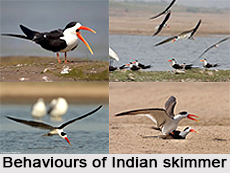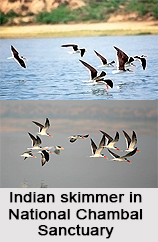 Indian Skimmer or Indian Scissors-Bill is an Indian bird that bears a scientific name "Rynchops albicollis" and has a similarity with tern but like other skimmers, have a short upper mandible and the longer lower mandible that is ploughed along the surface of water as the bird flies over the water to pick aquatic prey.
Indian Skimmer or Indian Scissors-Bill is an Indian bird that bears a scientific name "Rynchops albicollis" and has a similarity with tern but like other skimmers, have a short upper mandible and the longer lower mandible that is ploughed along the surface of water as the bird flies over the water to pick aquatic prey.
Concentration of Indian Skimmer
Indian Skimmer is found in southern Asia, where it is patchily distributed and declining in numbers. They are mainly found in rivers or estuaries. They are very brightly marked in black, white and orange, making them difficult to miss.
Structure of Indian Skimmer
Indian Skimmer has a black cap and orange bill that contrasts with the white body. With its long wings it looks tern-like and is about 40 to 43 cm long with a wingspan of 108 cm. The upper parts of the body are dark black and the under parts are white. The black cap on the head leaves the forehead and nape white. The wings are long and pointed with a white trailing edge. The short, forked tail is white with blackish central feathers. The long, thick bill is orange with a yellow tip and, like the other skimmers, has a lower mandible which is longer than the upper mandible. The legs and feet are red. The lower bill is knife-like and flexible and the tip appears truncated. Young birds have bills that appear normal and with age the lower mandible grows. The upper mandible is capable of considerable mobility.
Bill of Indian Skimmer
The Bill of Indian Skimmer is larger with a black tip to the bill. The African Skimmer is smaller with more black in the tail and no white collar. In older times the Indian skimmer was also known as the Indian Scissors-Bill.
Residence of Indian Skimmer
Indian Skimmer is found on large rivers and lakes, swamps and coastal wetlands such as estuaries. It is most common on freshwater, particularly during the breeding season. Breeding colonies are on islands or sandy spits, usually in rivers. Its range has become increasingly fragmented in recent decades.
Habitats of Indian Skimmer
Indian Skimmer is found in some parts of Pakistan in the Indus river system of Kashmir and northern and central India along the Ganga River, Bangladesh and Myanmar and formerly occurred in Laos, Cambodia and Vietnam. Indian Skimmer is more widespread in winter and is found in coastal estuaries of western and eastern India as far south as Karwar Beach, Karnataka on the western coast and; Chennai and Puducherry in the eastern coast exist.
Feedings of Indian Skimmer
Indian Skimmer forage for food by flying low over the water with the bill open and the lower mandible skimming through the water. When a fish is encountered, it moves up the lower mandible and the bird raises the upper mandible and snaps it with a movement of the head. They forage in small flocks and often associate with terns. They feed mainly on fish but also take small crustaceans and insect larvae. They often feed at dusk and can be very nocturnal.
 Breeding Season of Indian Skimmer
Breeding Season of Indian Skimmer
The breeding season of Indian Skimmer is mainly March and May. They breed in colonies of up to 40 pairs, often with terns and other birds. The nest is a simple scrape on the ground mainly on open sand banks that provide unobstructed views of any oncoming predators.
Eggs of Indian Skimmer
The eggs of Indian skimmer are buff or white with brown blotches and streaks. There are three to five eggs in a clutch. The birds tend to incubate the eggs more during the cooler hours of the day and are often away from the nest during the hotter parts of the day. Incubating adults are said to indulge in belly-soaking behaviour to cool the eggs.
Population of Indian Skimmer
The population of Indian skimmer is now mainly within India and Pakistan and is estimated to be about 6,000-10,000 individuals. It is threatened by habitat loss and degradation, pollution and disturbance by humans. Most colonies are unprotected but some lie within nature reserves such as National Chambal Sanctuary, Uttar Pradesh.











